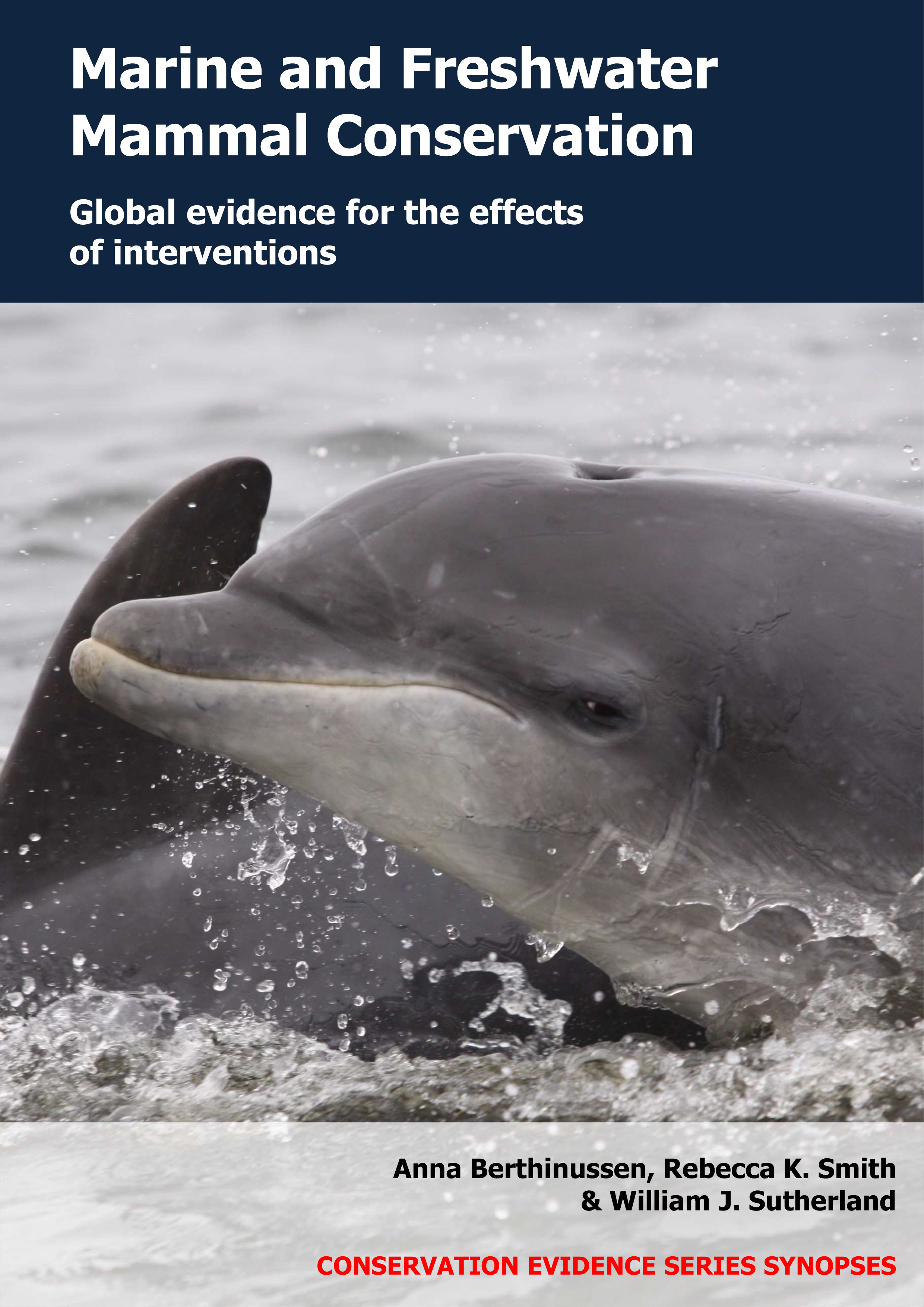Introduce and enforce regulations for marine and freshwater mammal watching tours
-
Overall effectiveness category Likely to be beneficial
-
Number of studies: 4
View assessment score
Hide assessment score
How is the evidence assessed?
-
Effectiveness
80% -
Certainty
60% -
Harms
0%
Study locations
Supporting evidence from individual studies
A controlled study in 1998 of a pelagic area in the North Atlantic Ocean around the Azores (Magalhães et al. 2002) found that when whale-watching boats followed regulations for approaching whales, sperm whales Physeter macrocephalus changed their swimming speed and performed aerial displays less often than when boats did not follow regulations, but direction of movement, swimming and diving patterns did not differ. When boats followed regulations, whales changed their swimming speed less often (three occasions) and performed fewer aerial displays (two occasions) than when boats did not follow regulations (changed swimming speed: 19 occasions; aerial displays: 20 occasions). No significant changes in direction of movement or swimming and diving patterns were observed when boats did or did not follow regulations (see original paper for details). Regulations were followed during 16 of 40 encounters between whale-watching boats and sperm whales. Regulations required boats to approach whales from behind at an angle of 60°; to maintain a distance of at least 100 m (400 m for ≥2 boats); and to limit encounters to ≤30 minutes. The behaviour of 80 sperm whales was recorded by a researcher on board a whale-watching vessel during each of the 40 encounters in July–September 1998.
Study and other actions testedA replicated, controlled study in 2004–2006 at three sites in the Cananéia estuary, São Paulo, Brazil (Filla et al. 2009) found that when tour boats followed regulations for approaching dolphins, fewer Guiana dolphins Sotalia guianensis had negative reactions to the boats compared to when regulations were not followed. Overall, fewer Guiana dolphins moved away, changed direction, altered their dives or separated from groups when tour boats followed approach regulations (6 of 84, 7%) than when they did not (18 of 19 dolphins, 95%). The other Guiana dolphins encountered did not appear to react (with regulations: 37 of 84 dolphins, 44%; without regulations: 0 of 19 dolphins, 0%) or had positive reactions (following, fishing or surfing alongside the boat; with regulations: 41 of 84 dolphins, 49%; without regulations: 1 of 19 dolphins; 5%). Dolphin-watching tours of three types (59 short cruises, 16 long cruises, eight educational courses) were carried out between December and March 2004–2006. Skippers either followed approach regulations (approached to 100 m slowly and from the side) or did not (approached within 3–50 m, passed through or chased groups of dolphins; number of tours for each not reported). Onboard observers recorded approach procedures and dolphin behaviour during each of 83 tours for a total of 112 h.
Study and other actions testedA controlled study in 2002–2003 and 2005 in a pelagic area in the South Pacific Ocean, Australia (Stamation et al. 2010) found that when whale-watching vessels followed regulations for approaching whales, fewer humpback whale Megaptera novaeangliae pods avoided vessels and fewer pods with calves slipped under the water surface compared to when vessels did not follow regulations, but diving behaviours did not differ. A lower percentage of whale pods with or without calves avoided vessels when regulations were followed (combined total with and without calves: 16 of 137 pods, 12%) than when they were not (17 of 67 pods, 25%). ‘Slip-under’ rates were lower for pods with calves (but not pods without calves) when vessels followed regulations than when they did not (data not reported). Diving behaviours (dive rates, blow rates, average dive times, average blow intervals and the percentage of time spent submerged) did not differ significantly for whale pods with or without calves when vessels did or did not follow regulations (data not reported). In September–November 2002, 2003 and 2005, five commercial vessels (12–16 m long, carrying 23–72 passengers) conducted 98 whale-watching tours. Regulations required vessels to maintain minimum approach distances of ≥200 m for pods with calves and ≥100 m for pods without calves. An onboard observer recorded the behaviour of whale pods during tours that followed regulations (total 137 pods) or did not follow regulations (total 67 pods).
Study and other actions testedA study (year not stated) on a rocky island shoreline in the northern Bass Strait, Australia (Back et al. 2018) found that increasing the approach distance of boats to an Australian fur seal Arctocephalus pusillus doriferus colony resulted in more seals remaining on the shore and fewer seals entering the water. When boats approached the seal colony to 75 m, a similar number of seals remained on the shore before, during and after the approaches in both the morning and the afternoon (data reported as statistical model results). Whereas, when boats approached to 25 m, the number of seals on shore declined by 47% during morning boat approaches and 21% during afternoon boat approaches. A breeding seal colony at a haul-out site was approached by boats (5.4–10 m in length) to distances of 75 m (20 approaches) or 25 m (18 approaches) during the morning and afternoon. Two video cameras and an observer recorded seal numbers and behaviour for 30 minutes before, 15 minutes during and 60 minutes after each of the 38 boat approaches in January–September.
Study and other actions tested
Where has this evidence come from?
List of journals searched by synopsis
All the journals searched for all synopses
This Action forms part of the Action Synopsis:
Marine and Freshwater Mammal Conservation
Marine and Freshwater Mammal Conservation - Published 2021
Marine and Freshwater Mammal Synopsis





)_2023.JPG)














